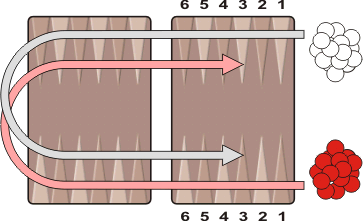![[Backgammon Galore!]](/gif/GaloreButton.gif)
|
|
Backgammon Variants Setup: Each player starts with fifteen checkers off the board. The players enter their checkers in the opponent's home board, then bring them around the board as shown in the diagram below.
Object: The object of the game is to move all of your checkers around the board to your own home table and then bear them off. The first player to bear off all of his checkers wins the game. To start: Each player rolls one die and the higher number goes first. That player then rolls both dice again to begin his first turn. Entering checkers: You enter a checker by placing it on a point in the opponent's home board corresponding to a number rolled. For example, if you roll 6-3, then you enter one checker on the opponent's six-point and one checker on his three-point. Once you have entered one or more checkers, you may use subsequent rolls to move those checkers forward, to enter more checkers, or both. Movement: The roll of the dice indicates how many points, or pips, the player is to move his checkers. The following rules apply:
Doubles: Rolling doubles is especially valuable. This is what happens:
If you are unable to use any part of a roll, you lose the rest. For example, if you roll 4-4 and can only play three of your 4's. Then you are not allowed to play any of the 3's on the other side of the dice, and you do not get to roll again. Acey-deucey: The roll of 1 and 2 (acey-deucey) lets you have a free a double of your choice:
Hitting: A checker sitting alone on a point is called a blot. If an opposing checker lands on a blot, the blot is hit and placed on the bar. Entering from the bar: Any time you have one or more checkers on the bar, your first obligation is to reenter those checker(s) into the opponent's home board. You reenter a checker by moving it to an open point corresponding to one of the numbers on the rolled dice. If you are able to enter some but not all of your checkers on the bar, you must enter as many as you can then give up the remainder of your turn. Bearing Off: Once all of your checkers are in your own home board, you may no longer move forward and can only use numbers rolled to bear off. You bear off a checker by rolling a number that corresponds to the point on which it resides, then removing the checker from the board. Unlike in backgammon, you must roll the exact number required to bear off. If you roll a number corresponding to a point with no checkers on it, then you lose that part of your roll. Scoring: The winner scores one point for a win. There are no gammons or backgammons. There is no doubling cube in this game, though some people play that each roll of 1-2 during the game automatically doubles the stakes.
References
|
![]()
Backgammon Galore : Variants

